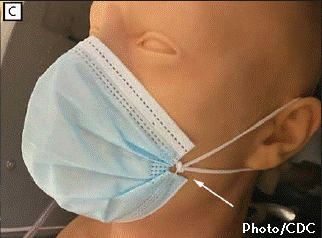There are several things to consider when making face covering choices to help protect yourself and others: Quality of Fit, Quality of Material and Consistency of Use. Wearing an effective mask paired with everyday prevention actions will help keep you and your community safe.
Mask Fit Factors
Quality of Fit
Make sure your face covering fully covers your nose and mouth and that it fits snugly against your face by avoiding any gaps. The best materials in the world are not effective if there are gaps that allow air to flow easily around the edges of the face covering. Visit the CDCs Your Guide to Masks page for more information.
Ways to make a snug fit face covering:
- Facial hair can reduce a snug fit against the face even if you don’t see large gaps.
- Adjustable ear loops and ear savers can reduce gaps.
- Evaluate “double masking” carefully as it could improve fit by preventing gaps or it could decrease fit by creating gaps.
If you find surgical masks are too big for you, watch the CDC's brief video, which shows how to create this knot on a surgical mask for better fit on smaller faces.
Quality of Material
Choose multi-layer woven fabrics or non-woven “surgical style” disposable materials. These types of materials allow air molecules to pass through while reducing potentially infectious respiratory droplets from easily passing through during normal breathing and talking. A good quality face covering filters droplets while allowing a person to breathe normally. If the material is:
- Too thick or there are too many layers, air may be forced to flow in and out along the edges of the face covering, rather than through the material reducing benefits.
- Take care when “double masking” as this practice could create the issue above if both face covers together create too thick of layering.
- Too thin, droplets may easily pass through also reducing benefits.
- “Double masking” of thin materials may improve benefits if no gaps are present.
Try the tip below for a quick evaluation of the quality of your face covering material’s ability to help reduce droplet spread. At home or outside away from others:
- Without wearing your face covering, hold a facial tissue at arm’s length in front of you and blow at it as if you are blowing out a candle. You will see the tissue move easily.
- Now repeat with your face covering on. If you still see the tissue move easily, the material of your face covering may not be beneficial. Consider another material or “double masking”
The CDC provides more information on ways to Improve How Your Mask Protects You.
Consistency of Use
It is recommended that you wear a face covering when you are near anyone who is not part of your household.
Continuation of Other Everyday Preventive Actions
Face coverings are only one part of the measures that need to be followed for everyone's safety. Don’t forget:
- Physical (social) distancing is the best preventative action. You cannot become infected or infect someone else if you don’t share your breathing spaces. Social Distancing
- Washing or sanitizing hands before and after handling face coverings and throughout the day is still important. How to Protect Yourself & Others
- Staying home if you have symptoms or have been exposed to someone who has tested positive. (COVID-19): Isolate If You Are Sick, COVID-19: When to Quarantine
- To take care of yourself! Care for Yourself
